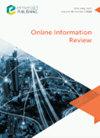Citation pattern of open access and toll-based research articles in the field of biological and physical sciences: a comparative study
IF 3.1
3区 管理学
Q2 COMPUTER SCIENCE, INFORMATION SYSTEMS
引用次数: 0
Abstract
PurposeThe purpose of this paper is to determine the relationship between the access mode of research articles [Open Access (OA) and Toll-Access (TA)] and their subsequent citation counts in Biological and Physical Sciences in three Impact factor zones (High, Medium and Low).Design/methodology/approachThree subjects each from Biological Sciences (Biochemistry, Cell Biology and Genetics) and Physical Sciences (Astronomy, Oceanography and Optics) were selected for the study. A comprehensive list of journals (TA and OA) in select subjects of Biological and Physical Sciences was prepared by consulting Journal Citation Report’s Master Journal List (for the compilation of both Open Access and Toll Access journal list) and Directory of Open Access Journals (for the compilation of Open Access journal list). For each journal, essential details like content language, format, year of publication, access mode (Open Access or Toll Access), etc. were obtained from Ulrich’s Periodical Directory. Web of Science (WoS) was used as citations indexing tool in this study. The data set was run on the WoS to collect the citation data.FindingsThe results of the study indicate that open mode of access is not a prerequisite for higher citation boost as in the majority of the cases in this study, TA articles have garnered a greater number of citations as compared to open access articles in different Impact factor zones in Biological and Physical Sciences.Originality/valueA novel approach has been adopted to understand and compare the research impact of open access (OA) and toll access (TA) journal articles in the field of Biological and Physical Sciences at three Impact factor zone levels to reveal the citation metrics encompassing three parameters, i.e. citedness, average citation count and year wise distribution of citations in select subjects of Biological and Physical Sciences.Peer reviewThe peer review history for this article is available at: https://publons.com/publon/[DOI]/10.1108/OIR-01-2021-0029生物与物理科学领域开放获取与收费论文引用模式的比较研究
目的研究生物与物理科学领域在高、中、低三个影响因子区(Open access (OA)和Toll-Access (TA))中研究论文的获取方式与其后续被引次数之间的关系。设计/方法/方法从生物科学(生物化学、细胞生物学和遗传学)和物理科学(天文学、海洋学和光学)中分别选择了三个学科进行研究。参考Journal Citation Report的Master Journal list(用于Open Access和Toll Access期刊列表的编制)和Directory of Open Access期刊目录(用于Open Access期刊列表的编制),编制了生物和物理科学选定学科的综合期刊(TA和OA)列表。每一本期刊的基本细节,如内容语言、格式、出版年份、访问方式(开放存取或收费存取)等,都是从Ulrich期刊目录中获得的。本研究采用Web of Science (WoS)作为引文标引工具。数据集在WoS上运行以收集引文数据。研究结果表明,开放获取模式并不是提高引用率的先决条件,因为在本研究的大多数情况下,在生物科学和物理科学的不同影响因子区域,与开放获取的文章相比,TA文章获得了更多的引用。采用一种新颖的方法,从三个影响因子区水平来理解和比较开放获取(OA)和收费获取(TA)期刊文章在生物和物理科学领域的研究影响,以揭示包含三个参数的引用指标,即被引次数、平均被引次数和被引次数的年度分布。同行评议本文的同行评议历史可访问:https://publons.com/publon/[DOI]/10.1108/OIR-01-2021-0029
本文章由计算机程序翻译,如有差异,请以英文原文为准。
求助全文
约1分钟内获得全文
求助全文
来源期刊

Online Information Review
工程技术-计算机:信息系统
CiteScore
6.90
自引率
16.10%
发文量
67
审稿时长
6 months
期刊介绍:
The journal provides a multi-disciplinary forum for scholars from a range of fields, including information studies/iSchools, data studies, internet studies, media and communication studies and information systems.
Publishes research on the social, political and ethical aspects of emergent digital information practices and platforms, and welcomes submissions that draw upon critical and socio-technical perspectives in order to address these developments.
Welcomes empirical, conceptual and methodological contributions on any topics relevant to the broad field of digital information and communication, however we are particularly interested in receiving submissions that address emerging issues around the below topics.
Coverage includes (but is not limited to):
•Online communities, social networking and social media, including online political communication; crowdsourcing; positive computing and wellbeing.
•The social drivers and implications of emerging data practices, including open data; big data; data journeys and flows; and research data management.
•Digital transformations including organisations’ use of information technologies (e.g. Internet of Things and digitisation of user experience) to improve economic and social welfare, health and wellbeing, and protect the environment.
•Developments in digital scholarship and the production and use of scholarly content.
•Online and digital research methods, including their ethical aspects.
 求助内容:
求助内容: 应助结果提醒方式:
应助结果提醒方式:


